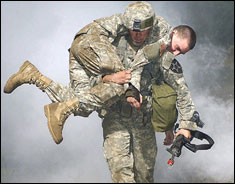Non-Lethal Weapons
|
Conventional weapons and overwhelming force can be used for all of these purposes, but sometimes only at the cost of significant collateral damage, serious injuries and deaths. Non-lethal weapons can reduce these risks, contributing to a military resolution to the conflict that will not be at odds with the political resolution of the conflict.
"Non-lethal" is not the same as harmless, and "non-lethal" doesn't always mean non-lethal. "Non-lethal really means "lethal less often than a lot of other things."
As a medical provider in military settings, it may prove useful to become familiar with the various non-lethal weapons and the injuries they can cause. These weapons include: No. 23FS-Rubber Fin Stabilized Round For more information, read:
|
From Operational Medicine 2001: Health Care in Military Settings
CAPT Michael John Hughey, MC, USNR
NAVMED P-5139
January 1, 2001
Bureau of Medicine and
Surgery,
Department of the Navy,
2300 E Street NW,
Washington, D.C,
20372-5300
United States Special Operations Command,
7701 Tampa Point Blvd.,
MacDill AFB, Florida,
33621-5323
Home · Textbooks and Manuals · Videos · Lectures · Distance Learning · Training · Operational Safety · Search
This website is dedicated to the development and dissemination of medical information that may be useful to those who practice Operational Medicine. This website is privately-held and not connected to any governmental agency. The views expressed here are those of the authors, and unless otherwise noted, do not necessarily reflect the views of
the Brookside Associates, Ltd., any governmental or private organizations. All writings, discussions, and publications on this website are unclassified.
© 2006 Medical Education Division, Brookside Associates, Ltd. All rights reserved
 Non-lethal weapons provide a military commander with a means of applying
force that is something less than a total destruction of the opponent and may be
less harmful to the environment. Non-lethal weapons are used to:
Non-lethal weapons provide a military commander with a means of applying
force that is something less than a total destruction of the opponent and may be
less harmful to the environment. Non-lethal weapons are used to: